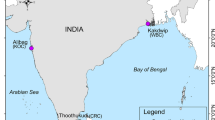Abstract
Triangle sail mussel (Hyriopsis cumingii) is the most important mussel species commercially exploited for freshwater pearl culture in China. Its genetic diversity was studied among populations from the five largest freshwater lakes of China, Poyang Lake (PY), Dongting Lake (DT), Taihu Lake (TH), Hongze Lake (HZ), and Chaohu Lake (CH), by the polymorphism of the inter-simple sequence repeats (ISSRs). Polymerase chain reaction (PCR) detections showed that a total of 62 loci were amplified from eight primers; of those, 31.88%, 31.15%, 31.03%, 27.27% and 26.92%, respectively, were polymorphic in each of the five populations across all genotypes tested. The average heterozygosities were 0.4747, 0.3274, 0.2366, 0.2099 and 0.2018 in each of these populations from PY, TH, DT, CH and HZ, respectively. Phylogenic analyses showed that PY and TH populations clustered with CH and HZ and formed a group, while the DT population on its own formed a separated branch. The smallest distance (0.0404) was scored between PY and TH populations, indicative of their closest relationship; the biggest distance (0.2438) was found between PY and DT populations, suggesting their greatest divergence. The present study provided genetic basis for managing mussel stocks from these lakes separately to best preserve the genetic diversity of H. cumingii. On the other hand, since the population in PY displayed the highest genetic diversity, it may be used preferably in future selective breeding to improve pearl yield and quality.


Similar content being viewed by others
Abbreviations
- PY:
-
Poyang Lake
- DT:
-
Dongting Lake
- TH:
-
Taihu Lake
- HZ:
-
Hongze Lake
- CH:
-
Chaohu Lake
- ISSR:
-
Inter-simple sequence repeat
References
Bai ZY, Li JL, Wang GL (2008) The relationship between the growth traits of Hyriopsis cumingii and the place of inserting mantle piece and pearl performance. J Fish Sci China 15:493–499
Esselman EJ, Jianqiang L, Crawford DJ, Winduss JL, Wolfe AD (1999) Colnal diversity in the rare Calamagrostis porteri ssp. Insperata (Poaceae): comparative results for allozymes and random amplified polymorphic DNA (RAPD) and inter simple sequence repeat (ISSR) markers. Mol Ecol 8:443–451. doi:10.1046/j.1365-294X.1999.00585.x
Fang DQ, Roose ML (1997) Identification of closely related citrus cultivars with inter-simple sequences repeat markers. Theor Appl Genet 95:408–417. doi:10.1007/s001220050577
Godwin ID, Aitken EAB, Smith LW (1997) Application of inter simple sequence repeat (ISSR) markers to plant genetics. Electrophoresis 18:1524–1528. doi:10.1002/elps.1150180906
Kim JE, Withler RE, Ritland C, Cheng KM (2004) Genetic variation with and between domesticated Chinook salmon, Oncorhynchus tshawytscha, train and their progenitor populations. Environ Biol Fishes 69:371–378. doi:10.1023/B:EBFI.0000022891.83210.2e
Li JL (2007) Exploitation and protection of genetic resources of freshwater pearl mussel. Sci Fish Farming 6:1–2
Li JL, Qian RH, Bao BL, Wang GL, Qi WD (2005) RAPD analysis on genetic diversity among the stocks of Hyriopsis cumingii from the five large lakes of China. J Shanghai Fish Univ 14:1–5
Li JL, Bai ZY, Qian RH (2006) Comparative study on growth performance among the stocks of Hyriopsis cumingii from the five large lakes of China and one cultured stock of Hyriopsis cumingii from Zhuji city. Fish Sci Technol Inf 33:243–246
Liu ZJ, Cordes JF (2004) DNA marker technologies and their applications in aquaculture genetics. Aquaculture 238:1–37. doi:10.1016/j.aquaculture.2004.05.027
Liu Y, Chen S, Li J, Li B (2006) Genetic diversity in three Japanese flounder (Paralichthys olivaceus) populations revealed by ISSR markers. Aquaculture 255:565–572. doi:10.1016/j.aquaculture.2005.11.032
Miller MP (1997) Tools for population genetic analysis (TFPGA) version 1.3: a windows program for the analysis of allozyme and molecular population genetic data. Department of Biological Sciences, Northern Arizona University, Flagstaff, AZ
Nagaoka T, Ogihara Y (1997) Applicability of inter-simple sequence repeat polymorphisms in wheat for use as DNA markers in comparison to RFLP and RAPD markers. Theor Appl Genet 94:597–602. doi:10.1007/s001220050456
Nei M (1978) Estimation of average heterozygosity and genetic distance from a small number of individuals. Genetics 89:583–590
Norris AT, Bradley DG, Cunningham EP (1999) Microsatellite genetic variation between and within farmed and wild Atlantic salmon populations. Aquaculture 180:247–264. doi:10.1016/S0044-8486(99)00212-4
Qian W, Ge S, Hong DY (2001) Genetic variation within and among populations of a wild rice oryza granulate from China detected by RAPD and ISSR markers. Theor Appl Genet 102:440–449. doi:10.1007/s001220051665
Tave D (1993) Genetics for fish hatchery managers. Van Nostrand Reinhold, New York
Tsumura Y, Ohba K, Strauss SH (1996) Diversity and inheritance of inter-simple sequence repeat polymorphisms in douglas-fir (Pseu-dotsuga menziesii) and sugi (Cryptomeria japonica). Theor Appl Genet 92:40–45. doi:10.1007/BF00222949
Wang GL, Wang JJ, Li JL (2006) Preliminary study on applicability of microsatellite primers developed from Crassostrea gigas to genomic analysis of Hyriopsis cumingiii. J Fish China 1:30–38
Yeh FC, Yang RC, Boyle TBJ (1999) Popgene version 1.31: Microsoft Windows-based freeware for population genetic analysis. Molecular Biology and Biotechnology Centre, University of Alberta, and Centre for International Forestry Research, Canada
Ze YZ, Grace L, Loong CL, Yin X, Felicia F, Renee C et al (2006) Genetic analysis of Asian seabass stocks using novel polymorphic microsatellites. Aquaculture 256:167–173. doi:10.1016/j.aquaculture.2006.02.033
Zietkiewicz E, Rafalski A, Labuda D (1994) Genome fingerprinting by simple sequence repeat (SSR)-anchored polymerase chain reaction amplification. Genomics 20:176–183. doi:10.1006/geno.1994.1151
Acknowledgements
We wish to thank Qiqun Cheng of East China Sea Fisheries Research Institute for his assistance in the preparation of the manuscript. This work was supported by grants from the Basic Research Priorities Program of the Science (06DJ14003) and Shanghai Leading Academic Discipline Project (Y1101).
Author information
Authors and Affiliations
Corresponding author
Rights and permissions
About this article
Cite this article
Li, J.L., Wang, G.L. & Bai, Z.Y. Genetic diversity of freshwater pearl mussel (Hyriopsis cumingii) in populations from the five largest lakes in China revealed by inter-simple sequence repeat (ISSR). Aquacult Int 17, 323–330 (2009). https://doi.org/10.1007/s10499-008-9204-8
Received:
Accepted:
Published:
Issue Date:
DOI: https://doi.org/10.1007/s10499-008-9204-8




